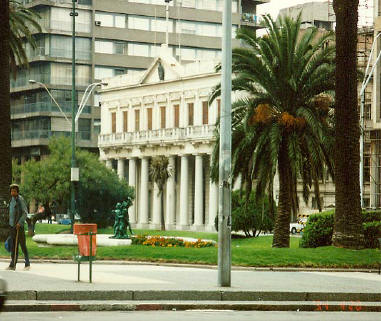|
||||||
|
History
Uruguay's aboriginal inhabitants were the Charrúa Indians, a hunter-gatherer people who cared little for outsiders. They killed the explorer Juan Diaz de Solís and most of his party when the Spaniards encountered them in 1516. By the 17th century, the Charrúas had prospered and, abandoning hostilities, began trading with the Spanish.
In 1680, the Portuguese founded Colonia on the estuary of the Río de la Plata as a rival to Spanish-held Buenos Aires on the opposite shore. Spain responded by building its own citadel at Montevideo. Uruguayan hero José Artigas fought against the Spanish but was unable to prevent a Brazilian takeover of the Banda (the original name of the eastern shore of the Río de la Plata). Exiled to Paraguay, he inspired the '33 Orientales' who, with Argentine support, liberated the area in 1828 and established Uruguay as an independent buffer state between Argentina and Brazil. |
|
|
Uruguay's fragile independence was repeatedly threatened during the 19th century - militarily by Argentina and Brazil, and economically by Britain. Federalist forces in collusion with Argentina besieged Montevideo from 1838-51 and helped create two warring political parties, the Blancos and the Colorados. Around the same time, the British introduced new wool, meat and rail industries. They also replaced the rangy criollo stock with their own cattle, thus commercializing one of the country's few abundant resources. For the remainder of the century, the contest between the Blancos and Colorados continued, immersing the country in civil war, dictatorship and political intrigue.
In the early 20th century, the visionary President José Batlle y Ordóñez achieved far-reaching reforms and made Uruguay the only 'welfare state' in Latin America. During his two terms as president - 1903-07 and 1911-15 - he implemented a range of free social services, abolished capital punishment and sought to curb the country's legacy of strong-arm rule. Uruguay soon flourished on the back of the rural livestock sector but its failure to grow, coupled with the country's lack of natural resources, meant the welfare state became increasingly fictitious over time.
The country's former prosperity had ebbed away by the 1960s as state-supported enterprises became riddled with corruption. The country slid into dictatorship and was thrown into turmoil by the Tupamaros, an urban guerrilla movement which appeared publicly in 1967. In 1971, the military was invited to participate in government, Congress was dissolved, and the Tupamaros were effectively wiped out.
The much-hated military continued to hold sway in national politics until 1984 when Julio María Sanguinetti won the presidential election. His government implied a return to democratic traditions and fostered a process of national reconciliation beginning with a widespread political amnesty, but there were no new radical economic policies. In 1990, free-market reformer Luis Alberto Lacalle took office. However, in 1994, considerable opposition to Lacalle's plans for wage restraint, spending cuts and major state sell-offs paved the way for Sanguinetti to once again take control. |
|

